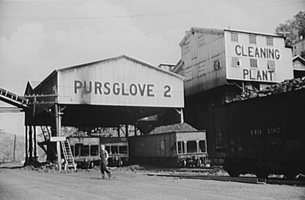 | Back to e-WV
| Back to e-WV
 The West Virginia Encyclopedia
The West Virginia Encyclopedia
 | Back to e-WV
| Back to e-WV
 The West Virginia Encyclopedia
The West Virginia Encyclopedia

By 1942, despite decades of production, the numerous coal operations of the Scotts Run district near Morgantown had never experienced a mining disaster. Then, with the mines in full production for World War II, three disasters within eight months killed 89 miners.
On May 12, 1942, a worker in Christopher No. 3 at Osage left a ventilation door open, and methane accumulated in a dusty area of the mine. At 2:25 p.m. an electric arc from machinery set off an explosion which coursed through three sections, killing 53 miners, destroying ventilation apparatus, and causing roof falls. Three others later suffocated in the noxious ‘‘afterdamp’’ gasses along the main haulageway. Several miners elsewhere in the mine managed to reach safety through a return airway.
On July 9, 1942, a roof fall in nearby Pursglove No. 2 Mine suspended a volume of coal dust into a methane-charged atmosphere and dislodged a trolley wire. An arc between the wire and track ignited the mixture and sent an explosion through two of the mine’s sections, killing 20.
The misfortunes of Scotts Run continued when early on January 8, 1943, a haulage locomotive fire spread to the coal seam. Ventilation currents carried the heavy smoke into the working sections, and the midnight foreman perished in an attempt to open trap doors and cut off the air. Sixty-five miners made it to safety, but one mine crew and the motorman remained unaccounted for. All 12 miners perished. On January 24, officials decided to flood and seal the mine. Seals were removed on April 23, 1943, but de-watering the mine proved difficult and the body of the missing motorman was not located until May 20, 1944.
Written by Paul H. Rakes
Humphrey, H. B. Historical Summary of Coal-Mine Explosions in the U.S., 1810-1958. Washington: United States Government Printing Office, 1960.
Rakes, Paul H. Casualties on the Homefront: Scotts Run Mining Disasters during World War II. West Virginia History, (1994).